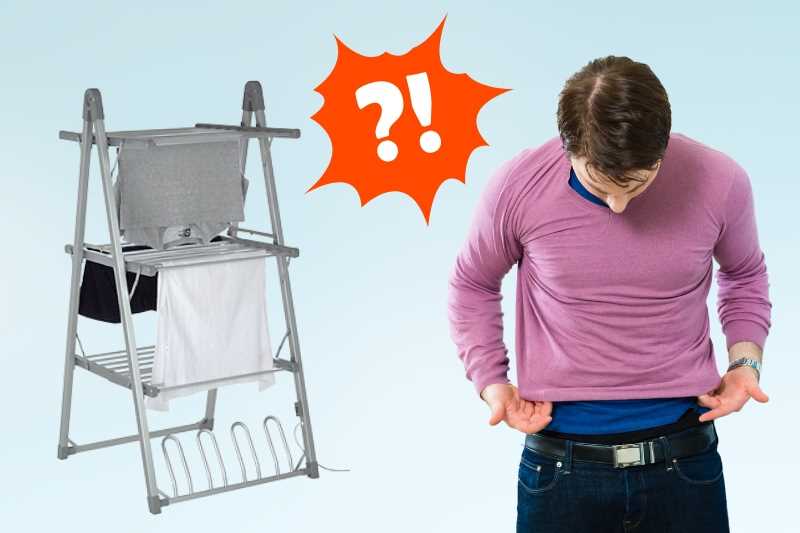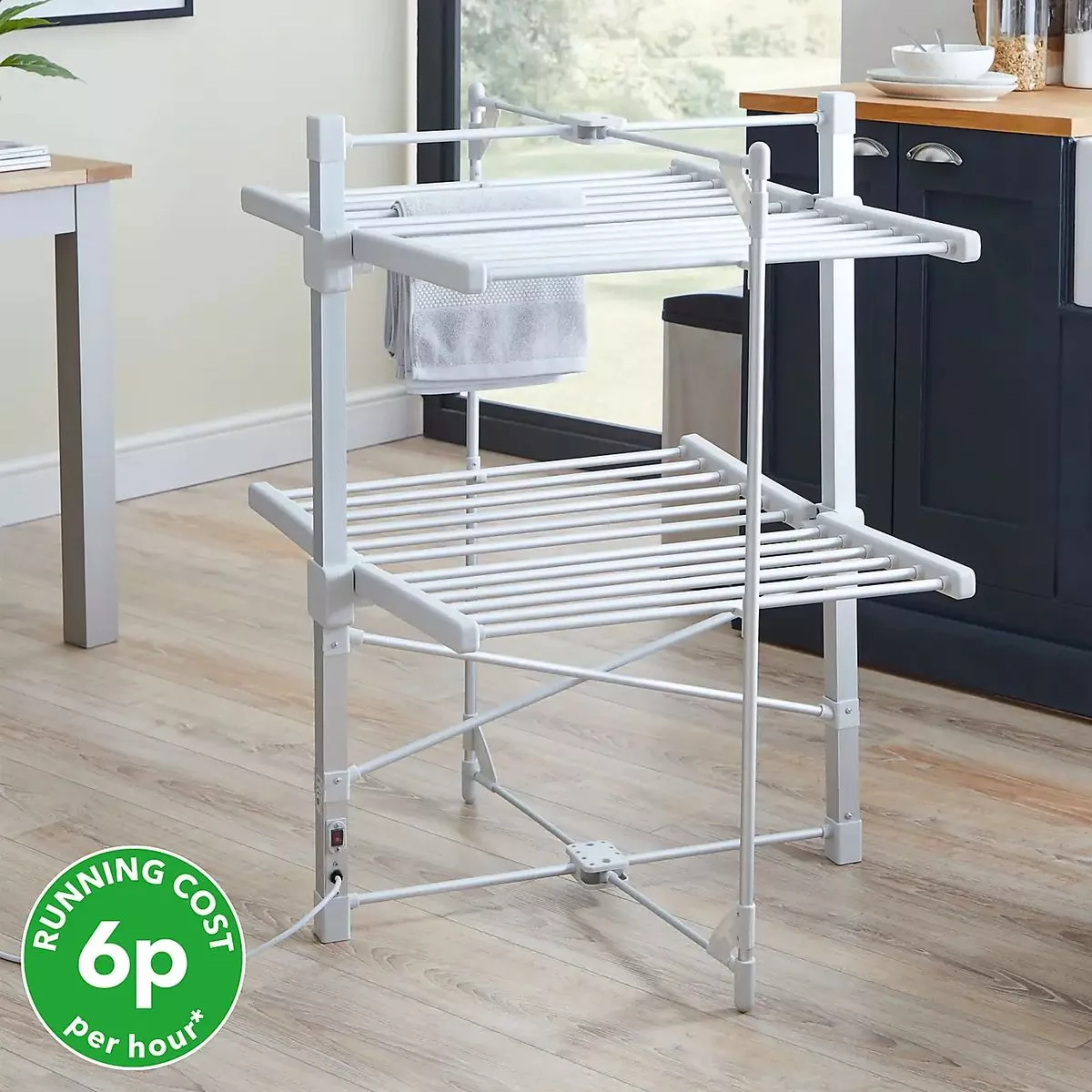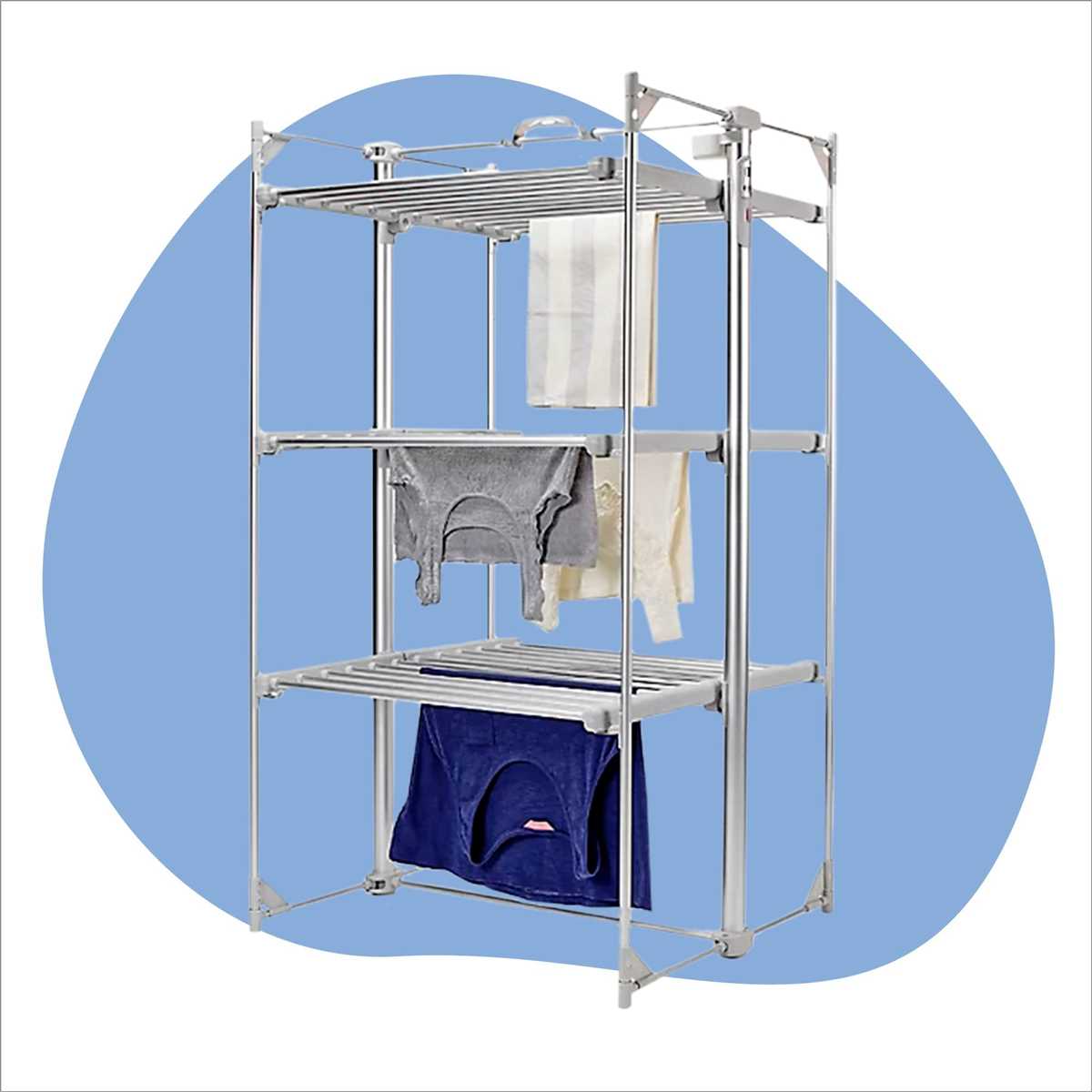




Heated airers, also known as heated clothes airers or clothes drying racks, have become increasingly popular in recent years as an alternative to traditional line-drying or tumble-drying. These devices use heated bars or racks to dry clothes, eliminating the need for a tumble dryer and reducing energy costs.
One concern that some people may have is whether heated airers can cause dampness in the home. After all, the idea of using heat to dry clothes indoors may seem counterintuitive, especially in a climate where dampness is already a problem.
However, the answer to whether heated airers can cause dampness depends on a few factors. Firstly, it’s important to use a high-quality heated airer that has built-in safety features such as a thermostat or timer to prevent overheating. These features can help ensure that the airer does not generate too much moisture or heat that could lead to dampness.
Additionally, proper ventilation is crucial when using a heated airer. Opening windows or running a dehumidifier can help remove any excess moisture from the air, preventing dampness from occurring. Regularly rotating and shaking out the clothes on the airer can also help circulate air and prevent dampness.
Can Heated Airers Cause Damp?
Heated airers are a popular choice for many people to dry their clothes indoors. These devices work by providing a source of heat that helps the clothes dry faster. However, there has been some concern that heated airers can cause dampness in the surrounding area. In this article, we will examine whether there is any truth to these claims.
The Science Behind Dampness
Dampness is caused by excess moisture in the air, which can lead to the growth of mold and mildew. It typically occurs in areas with poor ventilation or high humidity levels. When clothes are hung up to dry indoors, they release moisture into the air, increasing the humidity. If the humidity is not properly controlled, it can create the perfect environment for dampness.
How Heated Airers Work
Heated airers are designed to accelerate the drying process by providing a source of heat. These devices usually consist of several heated bars or racks where clothes can be hung. As the bars heat up, they transfer heat to the wet clothes, causing the water to evaporate more quickly. This helps to speed up the drying time compared to air-drying alone.
Potential for Dampness
While heated airers can help dry clothes faster, they can also increase the humidity in the surrounding area. If the room is not properly ventilated or if there is already high humidity, the excess moisture from the drying clothes can contribute to dampness. It is important to ensure that the room has adequate ventilation to prevent this issue.
Preventing Dampness
To prevent dampness when using a heated airer, there are several steps you can take:
- Ensure the room is adequately ventilated. Open windows or use a fan to circulate the air.
- Avoid drying clothes in rooms with already high humidity levels.
- Use a dehumidifier to remove excess moisture from the air.
- Regularly clean and maintain the heated airer to prevent the buildup of mold or mildew.
Conclusion
Heated airers can be a convenient and efficient way to dry clothes indoors. However, it is important to be mindful of the potential for dampness. By taking steps to properly ventilate the room and control humidity levels, you can enjoy the benefits of a heated airer without experiencing any dampness issues.
What Are Heated Airers?
Heated airers, also known as heated clothes airers or electric drying racks, are innovative household appliances designed to dry laundry indoors. Unlike traditional airers, which rely on air circulation or natural heat sources for drying clothes, heated airers provide a controlled and efficient drying solution.
These devices consist of a metal frame with multiple rails or bars for hanging clothes. The rails are heated via an electric element or wires, which radiate heat and warm up the surrounding air. This warm air then rises, creating a convection effect that helps to remove moisture from the clothes and accelerate the drying process.
Heated airers are compact and portable, making them suitable for smaller spaces or apartments where traditional drying methods are not feasible. They are also energy-efficient, as they consume less electricity compared to tumble dryers. With adjustable temperature settings, users can select the desired level of heat for drying different types of fabrics without causing damage.
Some heated airers offer additional features, such as timers, which allow users to set the drying duration. This feature helps prevent over-drying and ensures energy-efficient operation. They may also have foldable or collapsible designs for easy storage when not in use.
Heated airers are ideal for households with limited outdoor drying space, humid climates, or during colder months when hanging clothes outside can be challenging. They provide a convenient and effective alternative to tumble drying, reducing energy consumption and saving money on electricity bills.
How Do Heated Airers Work?

A heated airer is a useful and efficient household appliance that can help with drying clothes, especially during the colder months when it can be difficult to dry clothes outside. But how does a heated airer work? Let’s take a closer look.
Heating Element
At the heart of a heated airer is a heating element. This element is responsible for generating the heat that helps to dry your clothes. The heating element is usually located at the bottom of the airer, and it is designed to evenly distribute heat throughout the device.
Typically, the heating element is made of a metallic material, such as stainless steel or aluminum, which is resistant to corrosion and can withstand high temperatures. When the airer is turned on, an electric current passes through the heating element, causing it to heat up.
Air Circulation
In addition to the heating element, heated airers also have a built-in fan or air circulation system. This system helps to circulate warm air throughout the airer, ensuring that all your clothes are evenly dried.
The fan or air circulation system works by drawing in cool air from the surrounding environment, passing it over the heated element, and then expelling warm air back into the airer. This continuous circulation of warm air helps to speed up the drying process and ensures that your clothes dry quickly.
Hanging Space
Heated airers usually come with multiple bars or racks where you can hang your clothes. These bars are designed to provide ample space for hanging wet clothes, ensuring that they are exposed to the warm air for efficient drying.
Some heated airers also have additional features, such as adjustable drying shelves or wings, which can be useful for drying delicate items or for maximizing the drying space.
Energy Efficiency

One of the advantages of heated airers is their energy efficiency. They use significantly less electricity compared to traditional tumble dryers, making them a cost-effective and eco-friendly alternative.
Heated airers are designed to operate at lower temperatures, which not only saves energy but also helps to prevent damage to your clothes. The gentle warmth provided by the heated airer ensures that your clothes are dried without shrinking or losing their shape.
In conclusion, heated airers work by using a heating element to generate warm air, which is circulated throughout the device with the help of a fan or air circulation system. This warm air helps to dry your clothes quickly and efficiently. So, if you’re looking for a convenient and energy-efficient way to dry your clothes, a heated airer may be a great option.
The Myth of Dampness

Dampness is a common concern for many homeowners, and there are various myths surrounding its cause and prevention. One such myth is that heated airers can cause dampness in the home. However, this belief is not supported by scientific evidence.
Understanding Condensation
Condensation is often mistaken for dampness. It occurs when moist air comes into contact with a colder surface, causing the water vapor in the air to turn into liquid. This can lead to water droplets forming on surfaces such as windows or walls.
Heated airers, which generate warm air to dry clothes, do not directly cause condensation. In fact, they can help reduce moisture in the air by effectively drying wet laundry. However, if the air in your home has already high humidity levels due to poor ventilation or excessive moisture sources, condensation may still occur regardless of the use of heated airers.
Addressing the Root Cause
The key to preventing dampness is to address the root cause – excess moisture in the air. This can be achieved by improving ventilation in your home, using dehumidifiers to control humidity levels, and addressing any leaks or sources of water intrusion.
Using Heated Airers Responsibly
While heated airers do not directly cause dampness, it is essential to use them responsibly to ensure they do not contribute to high humidity levels in your home. Here are some tips:
- Do not overload the airer with too much laundry, as it can hinder air circulation and prolong the drying process, leading to higher humidity levels.
- Place the airer in a well-ventilated area and avoid drying clothes in confined spaces without proper airflow.
- Ensure your home has proper ventilation, including extractor fans in kitchens and bathrooms.
- Avoid drying clothes indoors when possible, as it can add excessive moisture to the air.
- Regularly clean and maintain your heated airer to prevent the accumulation of dust or lint, which can hinder its performance.
Conclusion
Heated airers do not directly cause dampness in the home. However, if your home already has high humidity levels, condensation may occur regardless of the use of heated airers. It is crucial to address the root cause of dampness by improving ventilation and controlling moisture levels in your home.
By using heated airers responsibly and taking the necessary steps to prevent excess moisture, you can enjoy the benefits of efficient clothes drying without worrying about dampness in your home.
The Benefits of Heated Airers
- Convenience: Heated airers provide a convenient way to dry clothes indoors, especially during cold or rainy seasons when outdoor drying is not an option.
- Energy-efficient: Unlike traditional tumble dryers, heated airers consume significantly less energy, which can lead to reduced energy bills.
- Gentle drying: Heated airers use a gentle heat to dry clothes, helping to preserve the quality and extend the lifespan of delicate fabrics.
- Space-saving: Many heated airers are designed with compact and foldable features, making them ideal for small living spaces or apartments where space is limited.
- Versatility: Heated airers can be used for drying various items, including clothes, towels, bed linens, and even shoes.
- Cost-effective: Investing in a heated airer can be a cost-effective alternative to purchasing a traditional tumble dryer, especially for individuals or households with lower drying needs.
- Reduced dampness: Unlike drying clothes on radiators or hanging them throughout the house, heated airers help reduce the risk of condensation and dampness in the home.
- Time-saving: Heated airers can dry clothes faster compared to air-drying, allowing you to wear your favorite outfit sooner.
- Odor reduction: Heated airers help minimize the occurrence of unpleasant odors often associated with clothes dried in enclosed spaces.
FAQ
Can heated airers cause damp in my home?
Heated airers can cause dampness if not used correctly. When clothes are hung on a heated airer, the moisture from the clothes evaporates into the air. If there is poor ventilation in the room, the excess moisture can lead to dampness and mold growth. It is important to ensure proper ventilation and avoid overloading the airer to prevent damp issues.
What are the signs of damp caused by heated airers?
The signs of damp caused by heated airers can include musty smells, condensation on windows, damp patches on walls or ceilings, and the growth of mold or mildew. If you notice any of these signs, it is important to address the issue promptly to prevent further damage and potential health risks.
How can I prevent dampness caused by heated airers?
To prevent dampness caused by heated airers, you can follow a few simple steps. Firstly, ensure that the room where the airer is placed has adequate ventilation. You can open windows or use a fan to improve air circulation. Secondly, avoid overloading the airer with too many clothes, as this can slow down the drying process and increase moisture in the air. Lastly, regularly check and clean the airer to remove any dust or lint that can impede airflow.
Are there any alternatives to using heated airers to dry clothes?
Yes, there are alternatives to using heated airers to dry clothes. You can opt for traditional methods such as hanging clothes on a clothesline outdoors if weather permits. Indoor alternatives include using a clothes drying rack or clothes horse, which allows for natural air drying without the need for heat. Additionally, using a tumble dryer with proper ventilation can also be an efficient method for drying clothes.














